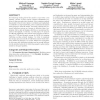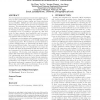MICRO
2009
IEEE
14 years 7 months ago
2009
IEEE
Dynamic Random Access Memory (DRAM) is used as the bulk of the main memory in most computing systems and its energy and power consumption has become a first-class design considera...
MICRO
2009
IEEE
14 years 7 months ago
2009
IEEE
Incorrect thread synchronization often leads to concurrency bugs that manifest nondeterministically and are difficult to detect and fix. Past work on detecting concurrency bugs ...
MICRO
2009
IEEE
14 years 7 months ago
2009
IEEE
Modern DRAM systems rely on memory controllers that employ out-of-order scheduling to maximize row access locality and bank-level parallelism, which in turn maximizes DRAM bandwid...
MICRO
2009
IEEE
14 years 7 months ago
2009
IEEE
With continued advances in CMOS technology, parameter variations are emerging as a major design challenge. Irregularities during the fabrication of a microprocessor and variations...
MICRO
2009
IEEE
14 years 7 months ago
2009
IEEE
As technology scaling drives the number of processor cores upward, current on-chip routers consume substantial portions of chip area and power budgets. Since existing research has...
MICRO
2009
IEEE
14 years 7 months ago
2009
IEEE
Aggressive technology scaling to 45nm and below introduces serious reliability challenges to the design of microprocessors. Large SRAM structures used for caches are particularly ...
MICRO
2009
IEEE
14 years 7 months ago
2009
IEEE
Efficient memory hierarchy design is critical due to the increasing gap between the speed of the processors and the memory. One of the sources of inefficiency in current caches is...
MICRO
2009
IEEE
14 years 7 months ago
2009
IEEE
Heterogeneous multiprocessors are growingly important in the multi-core era due to their potential for high performance and energy efficiency. In order for software to fully real...
MICRO
2009
IEEE
14 years 7 months ago
2009
IEEE
Process variations in integrated circuits have significant impact on their performance, leakage and stability. This is particularly evident in large, regular and dense structures...
MICRO
2009
IEEE
14 years 7 months ago
2009
IEEE
A key challenge in architecting a CMP with many cores is maintaining cache coherence in an efficient manner. Directory-based protocols avoid the bandwidth overhead of snoop-based ...


